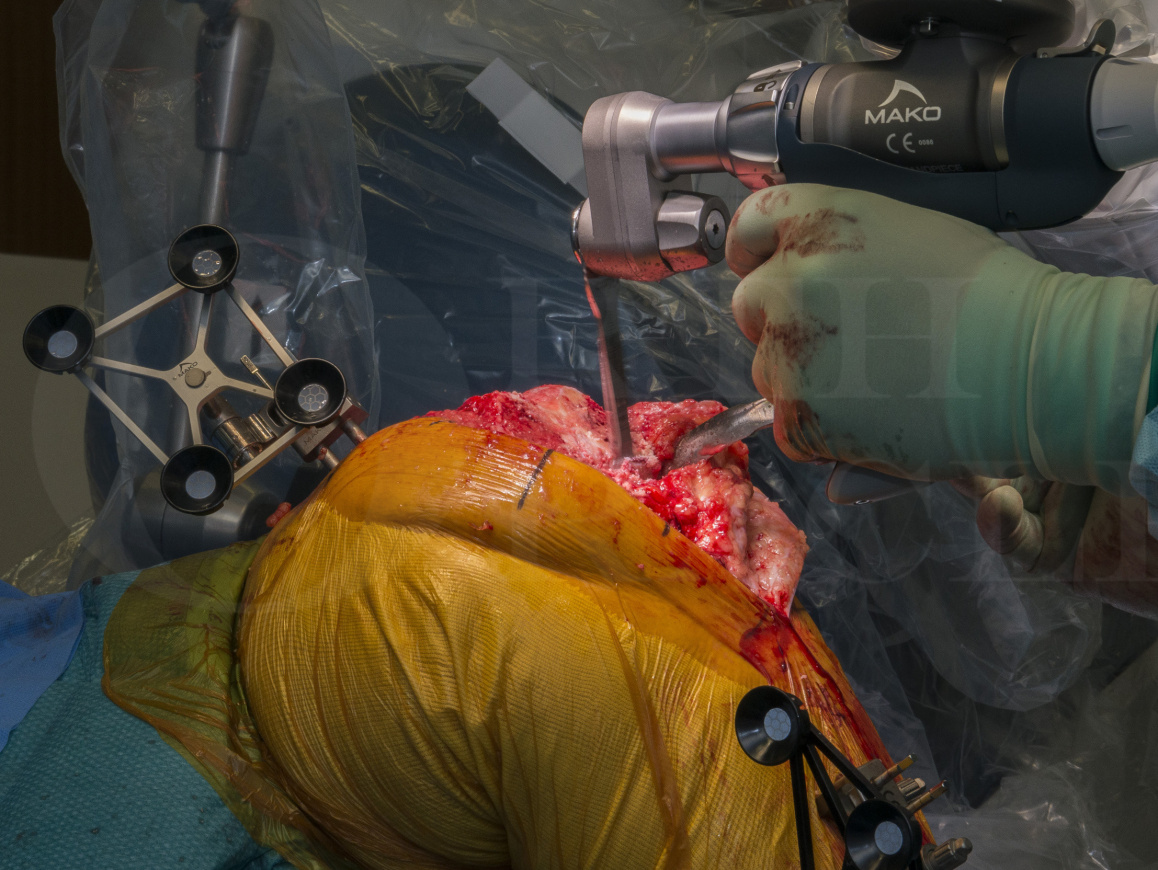Total Knee replacement: MAKO robotic triathlon cruciate substituting knee replacement
Overview

Subscribe to get full access to this operation and the extensive Knee Surgery Atlas.
Learn the Total Knee replacement: MAKO robotic triathlon cruciate substituting knee replacement surgical technique with step by step instructions on OrthOracle. Our e-learning platform contains high resolution images and a certified CME of the Total Knee replacement: MAKO robotic triathlon cruciate substituting knee replacement surgical procedure.
The Triathlon knee system from Stryker is a popular total knee replacement. It is an ODEP (Orthopaedic Data Evaluation Panel) 10A rated (10 year survivorship with a maximum of 7% revision rate) prostheses with good results in the National Joint Registry of England and Wales and has a failure rate of only 3.22% at ten years.
The philosophy of the Triathlon is that is has a single radius of curvature which increases the range of motion of the knee replacement. A single radius implant may lead to improved extension and therefore less quadriceps force when extending the knee. A single radius knee design may also improve the ligamentous balance of the collaterals throughout the full range of motion of the knee system. The polyethylene used in the TKR is from the X3 Stryker modern polyethylene range. The Triathlon knee replacement also has shortened and flared posterior condyles designed to allow a potential 150 degrees of flexion.
The Mako robotic system is an image guided, active, haptic feedback system. It is based on high resolution CT scans to map the anatomy of the knee and lower resolution images of the limb to measure alignment. This has potential advantages of accuracy but does require more planning and forethought. It is active in the sense that there is a robotic arm that moves into the plane of cuts to be performed. More passive systems like the Smith and Nephew Navio are simply active when in the right field and off when they are not. The Mako provides boundaries which allow for protection of soft tissues such as the patella tendon and (in cruciate retaining cases) the posterior cruciate ligament. Their haptic feedback system stops the blade from cutting if any part of the cutting teeth stray outside of the boundaries. The final part of the system is interactive planning and analytics to allow for assessments of implant size and position as well as soft tissue tension.
Stryker govern the use of the system and it is only compatible with their approved implants. It is only available to surgeons who have been trained on an approved Stryker course and is always done with a Makoplasty Technician present in theatre. You should spend time with your technician so they understand how you work and the philosophies you use in knee reconstruction. It doesn’t take long to get used to each other and learn each other’s ways. I strongly recommend spending time going through cases preoperatively and postoperatively with each other to start with. You will find different subtle changes which can help to streamline the process and save quite a lot of time. As you develop, most surgeons find the cases will take less than 20 percent longer than conventional techniques, within around 20 cases.
Using a robotic system like this is more expensive, time consuming and there is a learning curve (isn’t there always?). In order to be worthwhile, the surgeon must believe that the increased accuracy of ligament tension and bone cuts provide an improvement in function, longevity or both. The Mako system provides the most information and input of any robotic knee system and is the only robot advanced enough to remove the need for cutting blocks. However, it is the bulkiest and requires the most pre-operative imaging as well as a dedicated technician. If you enjoy control and freedom, the Navio system may be more to your liking. If you want masses of information and are willing to be part of a team with robot, technician and surgeon working together, the Mako system will be rewarding.
Readers will also find the following OrthOracle techniques of interest and in particular I recommend that all readers first familiarise themselves with the details of the Triathlon knee non-navigated technique before progressing to read the Mako version.
Total Knee replacement: Zimmer Biomet Nexgen rotating hinge replacement
Total Knee replacement: Mako Triathlon robotic assisted cruciate retaining TKR (STRYKER)
Total Knee replacement: MAKO robotic triathlon cruciate substituting knee replacement
Total knee replacement Genesis 2 (PS) with bi-convex patella (Smith and Nephew)
Total knee replacement: Vanguard XP cruciate retaining (Zimmer-Biomet)
Total knee replacement-Triathlon (Stryker) posterior stabilised knee.
Total knee replacement (posterior stabilised): Visionaire Genesis II (Smith and Nephew)
Total Knee Replacement: De Puy Attune implant
Total Knee Replacement: Vanguard cruciate retaining knee replacement(Zimmer-Biomet)
Total Knee replacement: Vanguard 360 knee replacement (Zimmer-Biomet)
Author: Mr Jonathan Miles FRCS (Tr & Orth)
Institution: The Royal National Orthopaedic Hospital, Stanmore, UK.
Clinicians should seek clarification on whether any implant demonstrated is licensed for use in their own country.
In the USA contact: fda.gov
In the UK contact: gov.uk
In the EU contact: ema.europa.eu
Online learning is only available to subscribers.



















